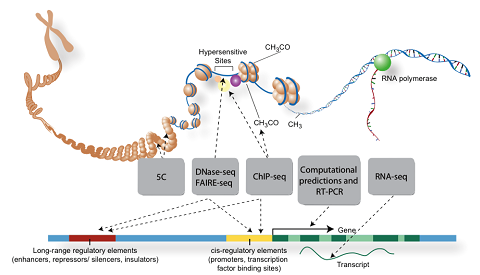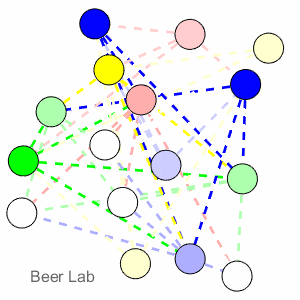Difference between revisions of "Computational Regulatory Genomics"
m |
|||
| (8 intermediate revisions by 2 users not shown) | |||
| Line 1: | Line 1: | ||
| − | [/ | + | <h2>Computational Regulatory Genomics</h2> __NOTOC__ __NOTITLE__ |
| + | <metadesc>Computational Regulatory Genomics for graduate PhD and postdoctoral research in BME and IGM at Johns Hopkins, top ranking programs modeling DNA and systems biology.</metadesc> | ||
| + | <h3>[[Recent News ]] [[Lab Members ]] [[Publications]] [[Postdoctoral Positions Available]] [[Resources]]</h3> | ||
| + | |||
| + | [[File:Beer_Michael_small.jpg|link=http://www.bme.jhu.edu/people/faculty/michael-beer/]] [[File:EncodeNatureGraphic_small.png]] [[File:dyn_net.gif]] | ||
| + | |||
| + | We are in the '''[http://www.bme.jhu.edu/people/faculty/michael-beer/ Department of Biomedical Engineering]''' and the '''[https://www.hopkinsmedicine.org/profiles/results/directory/profile/8377361/michael-beer McKusick-Nathans Department of Genetic Medicine]''' at Johns Hopkins University. You can apply for graduate study in my lab through '''[http://www.bme.jhu.edu/people/faculty/michael-beer/ BME]''' or the Ph.D. program in '''[https://www.hopkinsmedicine.org/profiles/results/directory/profile/8377361/michael-beer Human Genetics.]''' | ||
| + | |||
| + | <h3>Research Interests: </h3> The ultimate goal of our research is to understand how gene regulatory information is encoded in genomic DNA sequence. | ||
| + | |||
| + | We have recently made significant progress in understanding how DNA sequence features specify cell-type specific mammalian enhancer activity using machine learning, and how enhancer-gene networks control cell-fate decisions and contribute to human disease. For details, see: | ||
| + | |||
| + | * '''[https://www.annualreviews.org/doi/abs/10.1146/annurev-genom-121719-010946?journalCode=genom Enhancer Predictions and Genome-Wide Regulatory Circuits.]''' Beer MA, Shigaki D, Huangfu D. Ann. Rev. Genomics and Human Genetics 2020. | ||
| + | |||
| + | * '''[https://www.nature.com/articles/s41588-019-0408-9 Genome-scale screens identify JNK–JUN signaling as a barrier for pluripotency exit and endoderm differentiation. ]''' Li Q, et al. Nature Genetics 2019. | ||
| + | |||
| + | * '''[http://onlinelibrary.wiley.com/doi/10.1002/humu.23185/full Predicting enhancer activity and variant impact using gkm-SVM.]''' Beer, MA. Human Mutation 2017. | ||
| + | |||
| + | * '''[http://www.nature.com/ng/journal/vaop/ncurrent/full/ng.3331.html A method to predict the impact of regulatory variants from DNA sequence.]''' Lee D, Gorkin DU, Baker M, Strober BJ, Asoni AL, McCallion AS, Beer, MA. Nature Genetics 2015. | ||
| + | |||
| + | * '''[http://www.ploscompbiol.org/article/info%3Adoi%2F10.1371%2Fjournal.pcbi.1003711 Enhanced Regulatory Sequence Prediction Using Gapped k-mer Features.]''' Ghandi M, Lee D, Mohammad-Noori M, and Beer MA. 2014. PLOS Computational Biology. July 17, 2014. | ||
| + | |||
| + | and other [[Publications]]. | ||
| + | |||
| + | Our work uses functional genomics DNase-seq, ATAC-seq, ChIP-seq, RNA-seq, MPRA, Hi-C, and chromatin state data to computationally identify combinations of transcription factor binding sites which operate to define the activity of cell-type specific enhancers. We are currently focused on: | ||
| + | |||
| + | * improving machine learning algorithms by including more general sequence features and constraints | ||
| + | |||
| + | * predicting the impact of SNPs on enhancer activity (delta-SVM) and GWAS association for specific diseases | ||
| + | |||
| + | * experimentally assessing the predicted impact of regulatory element mutation in mammalian cells | ||
| + | |||
| + | * systematically determining regulatory element logic from ENCODE human and mouse data | ||
| + | |||
| + | * using this sequence based regulatory code to assess common modes of regulatory element evolution and variation | ||
| + | |||
| + | We are located in the McKusick-Nathans Institute of Genetic Medicine, and the Department of Biomedical Engineering, which has long been a leader in the development of rigorous quantitative modeling of biological systems, and is a natural home for graduate studies in Genomics, Bioinformatics, and Computational Biology at Johns Hopkins, including research in Systems Biology, Machine Learning, and Network Modeling. | ||
| + | |||
| + | <h3>About Computational Biology in JHU Biomedical Engineering:</h3> | ||
| + | |||
| + | The Department of Biomedical Engineering has long been a leader in the development of rigorous quantitative modeling of biological systems, and is a natural home for graduate studies in Bioinformatics and Computational Biology at Johns Hopkins. Students with backgrounds in Physics, Mathematics, Computer Science and Engineering are encouraged to apply. Opportunities for research include: Computational Medicine, Genomics, Systems Biology, Machine Learning, and Network Modeling. Graduate students in Johns Hopkins' Biomedical Engineering programs can select research advisors from throughout Johns Hopkins' Medical Institutions, Whiting School of Engineering, and Krieger School of Arts and Sciences. | ||
| + | |||
| + | <h3>[http://karchinlab.org/bme-compbio-jhu Visit Some Computational Labs at Johns Hopkins]</h3> | ||
| + | |||
| + | <h3>[http://ccb.jhu.edu/ Center for Computational Biology at Johns Hopkins]</h3> | ||
| + | |||
| + | [[File:bmesmall.png]] | ||
Revision as of 18:22, 26 May 2021
Computational Regulatory Genomics
Recent News Lab Members Publications Postdoctoral Positions Available Resources
We are in the Department of Biomedical Engineering and the McKusick-Nathans Department of Genetic Medicine at Johns Hopkins University. You can apply for graduate study in my lab through BME or the Ph.D. program in Human Genetics.
Research Interests:
The ultimate goal of our research is to understand how gene regulatory information is encoded in genomic DNA sequence.
We have recently made significant progress in understanding how DNA sequence features specify cell-type specific mammalian enhancer activity using machine learning, and how enhancer-gene networks control cell-fate decisions and contribute to human disease. For details, see:
- Enhancer Predictions and Genome-Wide Regulatory Circuits. Beer MA, Shigaki D, Huangfu D. Ann. Rev. Genomics and Human Genetics 2020.
- Genome-scale screens identify JNK–JUN signaling as a barrier for pluripotency exit and endoderm differentiation. Li Q, et al. Nature Genetics 2019.
- Predicting enhancer activity and variant impact using gkm-SVM. Beer, MA. Human Mutation 2017.
- A method to predict the impact of regulatory variants from DNA sequence. Lee D, Gorkin DU, Baker M, Strober BJ, Asoni AL, McCallion AS, Beer, MA. Nature Genetics 2015.
- Enhanced Regulatory Sequence Prediction Using Gapped k-mer Features. Ghandi M, Lee D, Mohammad-Noori M, and Beer MA. 2014. PLOS Computational Biology. July 17, 2014.
and other Publications.
Our work uses functional genomics DNase-seq, ATAC-seq, ChIP-seq, RNA-seq, MPRA, Hi-C, and chromatin state data to computationally identify combinations of transcription factor binding sites which operate to define the activity of cell-type specific enhancers. We are currently focused on:
- improving machine learning algorithms by including more general sequence features and constraints
- predicting the impact of SNPs on enhancer activity (delta-SVM) and GWAS association for specific diseases
- experimentally assessing the predicted impact of regulatory element mutation in mammalian cells
- systematically determining regulatory element logic from ENCODE human and mouse data
- using this sequence based regulatory code to assess common modes of regulatory element evolution and variation
We are located in the McKusick-Nathans Institute of Genetic Medicine, and the Department of Biomedical Engineering, which has long been a leader in the development of rigorous quantitative modeling of biological systems, and is a natural home for graduate studies in Genomics, Bioinformatics, and Computational Biology at Johns Hopkins, including research in Systems Biology, Machine Learning, and Network Modeling.
About Computational Biology in JHU Biomedical Engineering:
The Department of Biomedical Engineering has long been a leader in the development of rigorous quantitative modeling of biological systems, and is a natural home for graduate studies in Bioinformatics and Computational Biology at Johns Hopkins. Students with backgrounds in Physics, Mathematics, Computer Science and Engineering are encouraged to apply. Opportunities for research include: Computational Medicine, Genomics, Systems Biology, Machine Learning, and Network Modeling. Graduate students in Johns Hopkins' Biomedical Engineering programs can select research advisors from throughout Johns Hopkins' Medical Institutions, Whiting School of Engineering, and Krieger School of Arts and Sciences.



